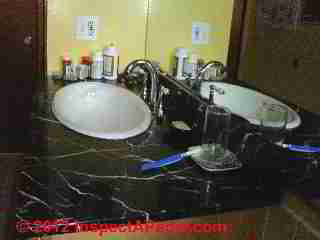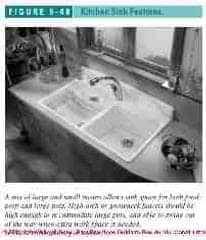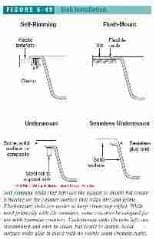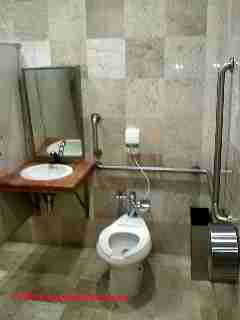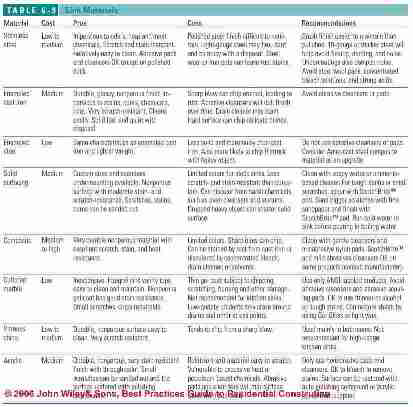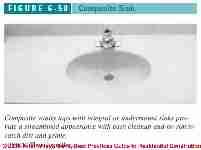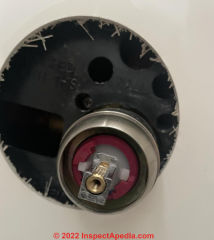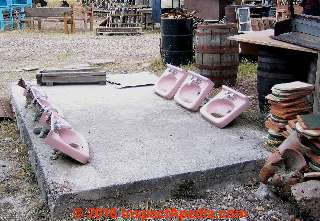 Plumbing Fixtures for Kitchens & Bathrooms
Plumbing Fixtures for Kitchens & Bathrooms
- POST a QUESTION or COMMENT about choosing & installing kitchen or bath sinks
Sink types, choices, recommendations for kitchens & baths:
This article provides a photo guide to all types of kitchen & bath sinks, tubs,toilets and discusses the properties, pros, and cons of different types of sinks and sink materials, including self-rimming sinks, flush mount sinks, and under mount sinks.
Here we discuss how to mount sinks, Mounting Procedures for Sink Fixtures: Self-rimming Sinks, Flush-set sinks, under-mount sinks & basins. Installing faucet assemblies on sinks - recommendations. Alternative types & materials for sinks: acrylic, composite, copper, cultured marble, enameled steel, enameled cast iron, solid surfacing sinks, stainless steel sinks, stone sinks, vitreous china & porcelain sinks.
We discuss the choices of enameled steel sinks, solid surfacing and composite sinks, cultured marble sinks, vitreous china (porcelain) sinks, acrylic sinks and basins, stainless steel sink properties, and enameled cast iron sinks.
InspectAPedia tolerates no conflicts of interest. We have no relationship with advertisers, products, or services discussed at this website.
- Daniel Friedman, Publisher/Editor/Author - See WHO ARE WE?
Design Guide to Plumbing Fixtures for Kitchens & Bathrooms
This article series reviews current best design practices for kitchens and bathrooms, including layout, clearances, work space, and accessible kitchen and bathroom layout, clearances, turning space, grab bars, controls, etc.
We include advice on choosing and installing kitchen countertops, cabinets, and kitchen or bathroom flooring, sinks, and other plumbing fixtures and fixture controls such as faucets.
[Click to enlarge any image]
Article Contents
- PLUMBING FIXTURES, KITCHEN, BATH - CONTENTS: Guide to choosing & installing plumbing fixtures, sinks, tubs, & faucets for kitchens & bathrooms
- Plumbing Fixture Mounting Recommendations for Sinks - how to mount sinks
- Acrylic sinks and basins, properties, features
- Composite Sink Guide, photos, properties
- Copper sinks
- Cultured Marble Sink Properties
- Enameled Steel Sink Choices
- Enameled Cast Iron Sink Properties
- SINK TYPES & MATERIALS - separate article
- Solid Surfacing Sink Choices & Composite Sink alternatives
- Specialty sinks: custom cast in cement, cut stone, hand-set tile, other forms
- Stainless Steel Sink Characteristics & Recommendations
- Stone Sinks: properties, photographs, applications
- Vitreous China Sink Choices - Porcelain Sinks
A list of kitchen and bath product manufacturers and sources is included. This article includes excerpts or adaptations from Best Practices Guide to Residential Construction, by Steven Bliss, courtesy of Wiley & Sons. We installed the oval porcelain sink (above left) in a cultured marble countertop. Be sure to seal the countertop after sink installation to avoid permanent water spot stain problems.
As discussed in Chapter 6 of Best Practices Guide to Residential Construction:
Plumbing Fixture Recommendations for Sinks
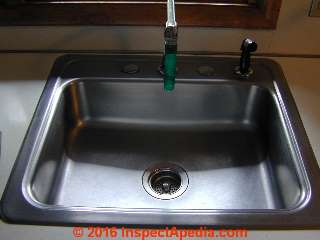
Because of its durability and economy, stainless steel accounts for over 60% of kitchen sinks in both new homes and remodels. In new construction bathrooms, cultured marble is the leading material for lavatory sinks, while the more expensive vitreous china leads in remodels.
Both stainless steel and vitreous china are extremely durable, easy to clean, and impervious to rust, stains, and heat.
Cultured marble quality varies, based largely on the thickness and quality of the thin gel coat that provides the color and wear surface.Well-made cultured marble, however, treated with reasonable care, can provide years of satisfactory service.
With any sink, choose a bowl that is large enough for the intended use. A kitchen sink should be deep enough to handle large pots and have vertical sides and tight-radius corners to increase the usable space.
A relatively flat bottom allows dishes to sit without sliding toward the drain, and an offset drain also increases the usable space. Models with multiple bowls and built-in cutting boards, draining racks, and other accessories can simplify both food prep at the sink and cleanup. A raised or gooseneck-type faucet allows large pots to be easily rinsed or filled (Figure 6-48just below).
[Click any image or table to see an enlarged version with additional detail, commentary & source citation.]
Many “builders’ grade” lavatory sinks are undersized for basic grooming tasks, such as tooth brushing and face washing without splashing water across the vanity top.
If the client plans to wash hair, water plants, or perform other household chores at the lavatory, an oversized bowl is recommended. A sink with the faucet offset to one side, with a pivoting spout, provides still more usable space.
Mounting Procedures for Sink Fixtures (Faucets)
Most kitchen and bath sinks are self-rimming and sit on top of the counter surface.
However, demand has been growing for flush-set and under mount sinks, which cost more to buy and install, but have the benefits of a more streamlined appearance and easy cleaning (Figure 6-49).
With the sink set level with or beneath the counter, food debris can be easily swept into the sink and grime does not collect at the joint of the sink rim and counter.
- Self-rimming Sinks. Standard cast-iron and stainless-steel sinks have a metal flange that hides any rough cuts in the countertop but tends to collect grime where it joins the counter. The rim should be sealed to the counter with silicone sealant.
- Flush-set Sinks. This type of sink, sometimes called a “tile edge”
sink, is designed to sit level with the countertop
and is often used with tile counters.With tile counters,
a flexible sealant such as Color Caulk (Color Caulk,
Colton, CA) should be used to seal between the sink
and tile.
Flush-set stainless-steel or cast-iron sinks can also be set into laminate counters by carefully routing a hole for the sink and using special trim that is virtually flush with the counter. European-based sink manufacturer Karran USA makes a reinforced solid surface sink specially designed to flush set in laminate tops. - Under mount Sinks and Basins. This type of sink provides the most streamlined appearance and easiest cleanup, but it is also the most costly to buy and install. Used with solid surfacing, stone, or composite tops, the cutout must be perfect, and most sinks must be independently supported from underneath the counter. Solid-surfacing sinks are typically glued to the countertop from underneath, creating a seamless transition.
The main material choices for kitchen and bathroom sinks are outlined below (Table 6-9).
[Click any image or table to see an enlarged version with additional detail, commentary & source citation.]
Acrylic Sinks for Baths & Kitchens: properties, pluses, minuses
A relative newcomer, acrylic sinks are made of the same materials as acrylic tubs or showers. Made from heat-molded 1/8 -inch thick acrylic plastic sheets, the fixtures are molded into a wide variety of shapes, then reinforced on the back side with fiberglass and resin.
The surface is nonporous and very stain-resistant, but it is relatively soft and easy to scratch. It is also vulnerable to petroleum based chemicals and heat, for example from a hot skillet. Burns are not repairable.
On the plus side, acrylic has good noise dampening characteristics and can tolerate bleach when needed for a difficult stain. The color goes all the way through the material, so it is possible to sand or buff out small scratches with auto polishing compound or special acrylic polish. For larger scratches, use 400- to 600-grit sandpaper and buff with baking soda.
Composite Sink Guide
Similar to solid surfacing, composite sinks are a cast polymer using crushed quartz or granite as the filler. High-quality composites have similar characteristics to engineered stone counters, and in some cases are seamlessly cast from the same material (Figure 6-50).
In general, they provide excellent resistance against stains, scratches, chips, and fading. They also tolerate heat well. For example, the sinks made from Moenstone (Moen) and Kindred Granite (FHP Kindred) can tolerate temperatures up to 530°F for short periods.
Finishes range from matte to a satin semigloss. Cleaning instructions vary from manufacturer to manufacturer, but most recommend mild nonabrasive cleansers and nylon scrub pads for everyday cleaning and ScotchBrite™ pads and abrasive cleansers as needed. Scratches or stubborn stains can be sanded out as with solid surfacing, although matching a glossy finish may be difficult (one solution is to sand the whole sink).
Metal scouring pads or cast-iron cookware can leave rust stains on composite sinks. Concentrated bleaches, paint strippers, or products containing formic acid (drain cleaner) can discolor the surface. An application of Gel-Glos™ (T.R. Industries) or Invisible Shield® (Unelko Corp.) is recommended by some manufacturers to maintain the sheen and ease of cleaning.
Copper Sinks
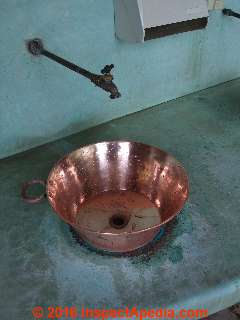
The copper sink and faucet shown at left is installed outdoors at the entrance to a public toilet found at El Charco del Ingenio, a botanical reserve located in San Miguel de Allende, Mexico.
This copper sink is attractive and easily accessed, but the practice of extending an outdoor hose bib horizontally some distance out from the wall to provide a faucet over the sink is asking for leaks in the copper piping.
To operate this faucet without bending the copper pipe requires some delicacy.
Cultured Marble Sink Properties
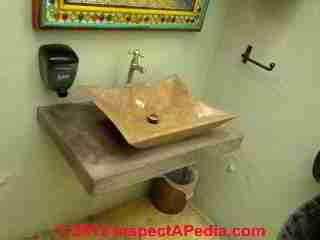
See Table 6-9 above for more details about the performance and care of cultured marble.
Enameled Steel Sink Choices
This uses the same process as enameled cast iron, but with a substrate of stamped 14-gauge steel. These sinks weigh half or less than a comparable cast-iron model, making them easier on the installer.
But the lighter, less rigid substrate does not dampen noise as well and is more likely to chip if a heavy object is dropped. One alternative is a hybrid from American Standard called Americast, introduced in the late 1980s, which uses enameled steel on the inside and a cast-polymer composite on the outside to create a sturdy tub with half the weight of cast iron.
Enameled Cast Iron Sink Properties
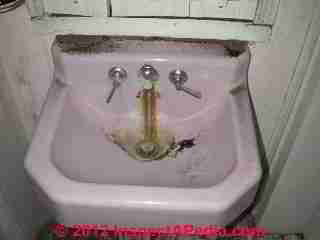
The hard, glossy finish on a cast iron sink is made by fusing a porcelain enamel glaze to a heavy cast-iron substrate under high heat. This creates a solid fixture with a tough, lustrous finish that is impervious to stains, chemicals, odors, and heat, and cleans easily with a sponge.
The heavy mass of the cast-iron base dampens any disposal sounds, but the same rigid mass will readily crack a dropped dish. The porcelain finish is durable but not indestructible.
Harsh, abrasive cleansers and abrasive pads will dull the surface and a hard enough blow with a sharp object can chip the coating exposing the iron beneath to rust.
The rust stains on this enameled cast iron sink are not the fault of the sink but rather of an unattended leak that has dripped for a long time.
Solid Surfacing Sink Choices

The main advantage of solid-surface sinks is that they can be installed seamlessly to the underside of a solid-surface counters. This provides a very streamlined appearance, easy cleanup, and no joints to collect dirt.
Solid surfacing also offers great design flexibility, as most fabricators can build nearly any configuration desired. Most solid surface sinks have a matte finish, which is easier to maintain than a semi gloss or high-gloss.
While relatively easy to scratch or scorch, this type of damage is superficial and is easy to sand away with fine sandpaper or a ScotchBrite™ pad.
The under-counter sink illustrated at left is installed in a cultured marble countertop in an office building bathroom in Queretaro, Mexico.
Stainless Steel Sink Characteristics & Recommendations
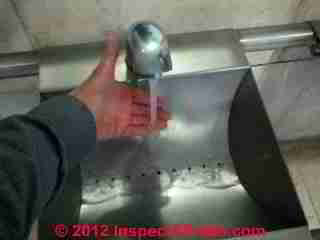
A basic stainless-steel sink is one of least expensive options, and one of the most durable.
Stainless steel used for sinks is unaffected by heat and most chemicals and the surface will not absorb stains, odors, or oils.
And stainless steel surfaces are relatively easy to clean and can be scrubbed with abrasive cleansers and pads when needed.
Avoid the cheapest sinks, which use lightweight steel (20 to 23 gauge), as they can flex or dent; also avoid low-nickel alloys, such as 18-8, which can tarnish. Lightweight steel sinks also tend to be noisy with a waste disposer. Good quality sinks are typically 18-gauge or thicker and use high-quality alloys, such as 18-10.
Also avoid steel sinks with a polished finish, which is difficult to maintain. A brushed (matte) finish hides scratches from normal use and cleaning. And although good quality stainless is tough to damage, it is not indestructible. It can develop rust stains from steel wool residue or prolonged contact with cast iron cookware. Also, prolonged contact with concentrated bleach solutions, strong acids, or salty materials can cause pitting. Still, for function and economy, steel is hard to beat.
Specialty sinks: custom cast in cement, cut stone, hand-set tile, other forms
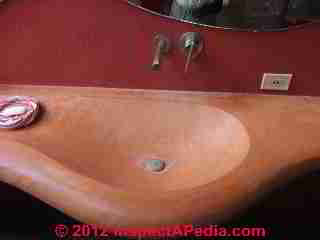
The sink shown at left is constructed of poured, formed and stained concrete.
Stone Sinks: properties, photographs, applications
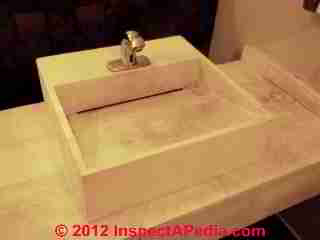

Vitreous China Sink Choices - Porcelain Sinks
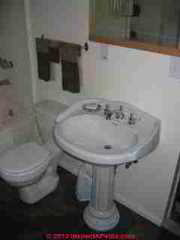
Also called porcelain, vitreous china is a heavy ceramic product also used to make toilets. It is highly scratch-resistant and less affected by abrasive cleansers than enameled cast iron or cast-polymer materials (solid surfacing, stone composites).
Porcelain or vitreous china is widely used in vanity sinks, but because the china substrate will chip more easily than other materials, it is not commonly used in kitchens.
Some high end ornamental china sinks are available for kitchens, but may be too fragile for a kitchen work center.
The porcelain sink and sink base shown in our photo, installed by the editor [DF] in a New York home is inexpensive and widely available from building suppliers in the U.S. The porcelain base supports the sink and hides the sink trap - making a drip proof trap installation a job for experienced, nimble fingers.
Kitchen and Bath Product Manufacturers, Sources, Associations
Kitchen & Bath Industry Associations
Association of Home Appliance Manufacturers(AHAM) www.aham.org
National Kitchen and Bath Association (NKBA) www.nkba.org
Ceramic Tile Institute of America www.ctioa.org
Home Ventilation Institute (HVI) www.hvi.org
Marble Institute of America www.marble-institute.com Porcelain Enamel Institute (PEI) www.porcelainenamel.com
Tile Council of America (TCA) www.tileusa.com
-- Adapted with permission from Best Practices Guide to Residential Construction (Steve Bliss, J Wiley & Sons) .
...
Reader Comments, Questions & Answers About The Article Above
Below you will find questions and answers previously posted on this page at its page bottom reader comment box.
Reader Q&A - also see RECOMMENDED ARTICLES & FAQs
On 2022-10-04 by InspectApedia-911 (mod) - HUD compliance questions about shower valve
@Charlie R,
What you found is repeating what I said earlier. Building codes and HUD rules by implication include manufacturers instructions. In other words you need to install a device by following the manufacturers instructions.
If the manufacturer provides mounting for a tub or shower control, it's most likely the instructions will say to use those points. I'm still waiting to see the instructions for the specific product that concerns you.
I still don't understand what HUD problem we're solving.
There's absolutely no argument that the plumbing control needs to be secured in the wall.
It also looks to me like it is so off-center with respect to the hole cut in what I think is a fiberglass tub or shower surround that I'm doubtful that the rest of the control fixture can be installed without it leaving an exposed hole in the wall that's going to leak.
So it seems to me that what's necessary is to properly locate the plumbing fixture in the wall so that the hole that's already cut in the tub or shower surround will be centered, and then support that control with a wooden frame and backer plate.
I don't understand why we're discussing HUD requirements at all.
If you're worried that this one technical detail makes your home not HUD compliant, I can only say that if this is an example of other work done on the home there may be many other errors, some of which could be more serious and need to be identified and corrected.
Here is HUD's position on mixing valves from 2015, courtesy of reader Charlie R.
- HUD, Update: INSTALLATION of MIXING VALVES and WATER TEMPERATURE LIMITING DEVICES (Anti-Scald Valves) [PDF] (2015) U.S. Department of Housing and Urban Development, Office of Housing, Letter from Pamela Beck Danner, Administrator, Office of Manufactured Housing Programs
Excerpt:
This is in follow-up to my memorandum of March 10,2015, that clarified responsibilities and guidance for manufacturers, IPIAs, and DAPIAs pertaining to the installation of mixing valves and water ternperature limiting devices (anti-scald valves) for shower and tub shower combinations and for bathtubs and whirlpool baths now required by the Manufactured Home Construction and Safety Standards. Specifically, $3280.607OX3Xv), requires: ...
On 2022-09-30 by Charlie R
@InspectApedia-911, The manufacturers web page says "4 anchor points for face plate installation and blocking to secure in wall" or "rough-in shower mixing valve with four anchor points", one even shows valve secured to a board. and when I asked about the anchor points, that's when I got their noncommittal reply.
What I REALLY need to know, is it HUD compliant if the valve is not secured inside the wall and just moving around. The pipes are Pex I think some kind of plastic Red & Black. I live in a 5 yr old Manufactured Home and it really matters if it's HUD compliant or not.
I think the manufacturer is great when it comes to standing behind their products but not when it comes HUD Questions.
This is what I found out.
- HUD rule "As a reminder, access must be provided in accordance with an approved design that will facilitate setting and adjustment of the devices as well as provide for ongoing maintenance in accordance with product manufacturer instructions.
- Manufacturer instructions go by national and local building codes.
- Local inspector said go by HUD rules. I don't seem to be able to get a definite answer.
On 2022-09-30 by InspectApedia-911 (mod)
@Charlie R,
What a ridiculous response from the manufacturer. Sounds like you never got to a decent person and it doesn't speak well for them or their product.
I'll do some further research see what I can post here.
A photo of the valve body or back should show us whether it's even made with ears or other fittings that would allow it to be secured to the wall framing.
Every plumbing tub or shower valve of this type that I have installed has such fittings but clearly there can be thousand more that neither of us has ever worked with.
If the valve includes no such fittings that would allow its body to be secured to the wall framing the manufacturer must think that you are supporting it by securing the plumbing Hot and Cold Supply pipes quite close by. That doesn't sound like a great design.
On 2022-09-30 by Charlie R
@InspectApedia-911, Hunting Brass valve #P0123199 or P1023199, and they use a ST6000 - Tub and Shower Cartridge. I asked them and this was their reply. "We are the valve manufacturer, so, we only recommend installation for the valve to function properly and the depth of the valve to the finish wall.
We don't recommend anything past that, it's up to the plumber to install the valve properly with all national and local building codes."
That is why I got in contact with you can't find out what is HUD approved secured behind the wall or loose behind the wall?
Got this from a HUD form. "As a reminder, access must be provided in accordance with an approved design that will facilitate setting and adjustment of the devices as well as provide for ongoing maintenance in accordance with product manufacturer instructions.
On 2022-09-29 by InspectApedia-911 (mod)
@Charlie R,
Please use the page top or bottom contact link where you'll find our email and you can send me a PDF of the instructions that we are discussing and then we can see what support they require for their valve.
Or you can give me the brand and model number of the valve and I can look for there installation instructions that way as well
On 2022-09-29 by Charlie R
@InspectApedia-911, Please see attached info sheet for installation instructions, so if I don't secure the valve you think it will not meet HUD Regs?
On 2022-09-29 by InspectApedia-911 (mod) - instructions call for securing the shower control
@Charlie R,
The installer is required to follow the manufacturers installation instructions.
Therefore the instructions call for securing the control, which normally they do, you would need to do that. If you don't, you're inviting a plumbing leak.
On 2022-09-29 by Charlie R
Does HUD require securing a shower valve behind the wall?
On 2021-01-05 - by (mod) -
Robert:
For many models, you can flip the shower valve but take care that the letters on the backplate correctly indicate H - hot and C- cold.
Check the installation instructions for your specific shower valve; the last one I installed addressed this question specifically.
On 2021-01-05 by Robert Rodriguez
Does it matter which way you put the shower valve. I understand it says “up” and has “h” for hot but my pipes are coming from the ceiling not the ground so can I just flip it ?
On 2020-11-17 - by (mod) -
Scott
I'm not sure but I think you're talking about ISLAND SINK PLUMBING VENTS
whose use is constrained
You might also want to see AIR ADMITTANCE VALVES AAVs & STUDOR VENTS
On 2020-11-17 by Scott
In CA, apparently a sink drain can not extend more than 5 feet horizontally, even with proper slope. What about a looped vent line?
On 2019-12-09 - by (mod) -
Agree that's odd; there could be a local anti-scald device or even simply a difference in flow rates due to clogging or a valve blockage; less likely would be exposure of the hot line to cold outdoor temperatures.
And yes in many cities municipal water supply is notably colder in cold weather months.
On 2019-12-09 by Will Beames
Thanks, I have already replaced the valve that takes the hot water produced by the boiler and reduces it to a more user friendly temperature. That then feeds the single line that then branches to all the domestic hot water.
What I don't understand is how the sink in the bathroom is scalding hot but the shower a few feet away is not even close to scalding. I moved into the house 15 months ago, within a few months I noticed that I was using less and less cold in the shower to make it the right temperature.
That was when I changed the valve. It made little difference, if any. However, then the weather warmed up (I'm in CT) and that seemed to have a reversing effect...maybe I just imagined it.
Anyway, now it's back again although this morning the water was hotter than it was yesterday....and the weather is warmer than it was yesterday. Coincidence or is city water colder in winter than it is in summer so is therefore affected by changing outside temperatures. Yesterday was 20 deg, today is 35. Thanks.
On 2019-12-09 - by (mod) -
Yes there are anti-scald devices and mixing valves that can be installed right at the shower controls.
However from your description it sounds as if the existing mixing valve for your hot water (at the heating boiler) OR a tankless coil at your boiler (that makes hot water for bathing) may be scale-clogged. It's worth having a local plumber take a look, and if appropriate, clean the coil.
See details at CLOGGED TANKLESS COIL or PIPES, LIME SCALE
On 2019-12-08 by Will Beames
The hot water in my bath/shower is steadily getting cooler to the point where we now only use hot water when showering. It's a three control fixture (hot, cold, diverter). Not a more modern mixer.
There is a watts thermostatic valve at the furnace which acts as anti scald for all the domestic hot water. However, while the bath and shower hot water is not that hot, the hot water in the bathroom sink is scalding. Both hot water fawcets are from the same feed, why would one be so much hotter than the other ?
Is there some kind of anti scald device built into the three control fawcets for the shower ? I can't see any other reason why the tub hot would be so much cooler than the sink hot in the same room from the same hot feed. Help please !!!
On 2016-10-2 - by (mod) -
Re posting without advertising link
Stefan Koziol said:
One must take some help from plumbing experts while facing any type of plumbing issues. They can provide with the best solution for plumbing problems .... which fits best in our budget. That will not only help to come up with a solution but will also save our time and money both.
...
Continue reading at FAUCETS & CONTROLS, KITCHEN & BATH or select a topic from the closely-related articles below, or see the complete ARTICLE INDEX.
Or see these
Recommended Articles
- BATH & KITCHEN DESIGN GUIDE
- SINK TYPES & MATERIALS
- HOT WATER QUANTITY DAILY USE - daily & peak hot water usage rate tables
- PLUMBING DRAIN FIXTURE UNITS DFUs - measure of the wastewater volume or loading of a drain waste or vent system
- SEWAGE FLOW & DESIGN FLOW ESTIMATES - plumbing fixture flow rates
- WATER QUANTITY USAGE TABLES - daily & peak water usage rate tables
Suggested citation for this web page
PLUMBING FIXTURES, KITCHEN, BATH at InspectApedia.com - online encyclopedia of building & environmental inspection, testing, diagnosis, repair, & problem prevention advice.
Or see this
INDEX to RELATED ARTICLES: ARTICLE INDEX to BATH & KITCHEN
Or use the SEARCH BOX found below to Ask a Question or Search InspectApedia
Ask a Question or Search InspectApedia
Questions & answers or comments about choosing & installing kitchen or bath sinks.
Try the search box just below, or if you prefer, post a question or comment in the Comments box below and we will respond promptly.
Search the InspectApedia website
Note: appearance of your Comment below may be delayed: if your comment contains an image, photograph, web link, or text that looks to the software as if it might be a web link, your posting will appear after it has been approved by a moderator. Apologies for the delay.
Only one image can be added per comment but you can post as many comments, and therefore images, as you like.
You will not receive a notification when a response to your question has been posted.
Please bookmark this page to make it easy for you to check back for our response.
IF above you see "Comment Form is loading comments..." then COMMENT BOX - countable.ca / bawkbox.com IS NOT WORKING.
In any case you are welcome to send an email directly to us at InspectApedia.com at editor@inspectApedia.com
We'll reply to you directly. Please help us help you by noting, in your email, the URL of the InspectApedia page where you wanted to comment.
Citations & References
In addition to any citations in the article above, a full list is available on request.
- Best Practices Guide to Residential Construction, by Steven Bliss. John Wiley & Sons, 2006. ISBN-10: 0471648361, ISBN-13: 978-0471648369, Hardcover: 320 pages, available from Amazon.com and also Wiley.com. See our book review of this publication.
- Our recommended books about building & mechanical systems design, inspection, problem diagnosis, and repair, and about indoor environment and IAQ testing, diagnosis, and cleanup are at the InspectAPedia Bookstore. Also see our Book Reviews - InspectAPedia.
- Best Practices Guide to Residential Construction, by Steven Bliss. John Wiley & Sons, 2006. ISBN-10: 0471648361, ISBN-13: 978-0471648369, Hardcover: 320 pages, available from Amazon.com and also Wiley.com. See our book review of this publication.
- HUMIDITY CONTROL & TARGETS INDOORS What indoor humidity should we maintain in order to avoid a mold problem?
- What Style Is It?: A Guide to American Architecture, Rev., John C. Poppeliers, S. Allen Chambers, Wiley; Rev Sub edition (October 6, 2003), ISBN-10: 0471250368, ISBN-13: 978-0471250364
- In addition to citations & references found in this article, see the research citations given at the end of the related articles found at our suggested
CONTINUE READING or RECOMMENDED ARTICLES.
- Carson, Dunlop & Associates Ltd., 120 Carlton Street Suite 407, Toronto ON M5A 4K2. Tel: (416) 964-9415 1-800-268-7070 Email: info@carsondunlop.com. Alan Carson is a past president of ASHI, the American Society of Home Inspectors.
Thanks to Alan Carson and Bob Dunlop, for permission for InspectAPedia to use text excerpts from The HOME REFERENCE BOOK - the Encyclopedia of Homes and to use illustrations from The ILLUSTRATED HOME .
Carson Dunlop Associates provides extensive home inspection education and report writing material. In gratitude we provide links to tsome Carson Dunlop Associates products and services.


